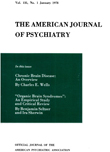Defining borderline patients: an overview
Abstract
This review of the descriptive literature on borderline patients indicates that accounts of such patients vary depending upon who is describing them, in what context, how the samples are selected, and what data are collected. The authors identify six features that provide a rational means for diagnosing borderline patients during an initial interview: the presence of intense affect, usually depressive or hostile; a history of impulsive behavior; a certain social adaptiveness; brief psychotic experiences; loose thinking in unstructured situations; and relationships that vacillate between transient superficiality and intense dependency. Reliable identification of these patients will permit better treatment planning and clinical research.
Access content
To read the fulltext, please use one of the options below to sign in or purchase access.- Personal login
- Institutional Login
- Sign in via OpenAthens
- Register for access
-
Please login/register if you wish to pair your device and check access availability.
Not a subscriber?
PsychiatryOnline subscription options offer access to the DSM-5 library, books, journals, CME, and patient resources. This all-in-one virtual library provides psychiatrists and mental health professionals with key resources for diagnosis, treatment, research, and professional development.
Need more help? PsychiatryOnline Customer Service may be reached by emailing [email protected] or by calling 800-368-5777 (in the U.S.) or 703-907-7322 (outside the U.S.).



